Introduction: EHR in the Acute Care Unit (ACU) Setting
- Electronic Health Records (EHR): innovative technology in nursing;
- EHR: allowing for an improved framework for patient data management;
- EHR: ostensibly helping to reduce mortality rates among ACU patients;
- Potential obstacles: problems promoting EHR as a nursing tool;
- Research goal: designing a framework for encouraging nurses to use EHR.
The introduction of Electronic Health Records (EHR) into the realm of contemporary nursing has affected the quality of care largely. By allowing nurses to collect patients’ data and analyze it systematically, the EHR framework has opened opportunities for reducing mortality rates among diverse populations. However, there are currently certain issues in managing the data provided with the help of EHR, which is believed to be attributed to the lack of respective skills among nurses. Therefore, the goal of the project is to design the framework for an intervention to be deployed in the nursing setting of the ACU to enable nurses to use EHR-based systems.
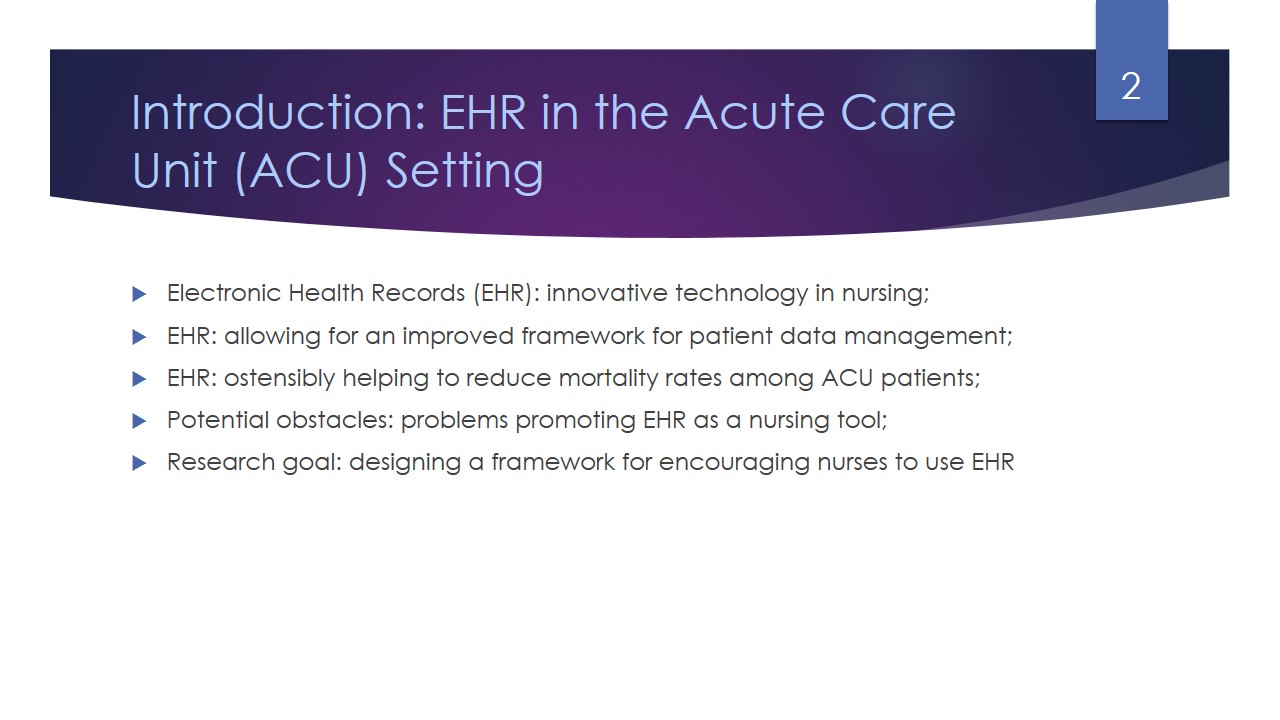
Theoretical Framework, Rationale, and Expectations
- Theoretical framework: Lewin’s Theory of Planned Change.
- TPC: nurse understaffing – nurse education – active use of EHR.
- TPC: focus on culture-specific needs of patients.
- EHR: introducing order into patients’ data management.
Freeze → Change → Unfreeze.
The study chooses to deploy Lewin’s Theory of Planned Change (TPC) as the means of encouraging a shift in the nurses’ perspective (Bakari, Hunjra, & Niazi, 2017). The framework requires completing three stages, which are unfreezing (locating the negative factors to be eliminated), changing (introducing a positive paradigm), and refreezing (institutionalizing change) (Burke, 2017). The use of the TPC also allows placing emphasis on patients and their individual needs, thus contributing to a rise in nursing service quality. Staff education is deemed as the central aspect of the project. The rationale, in turn, lies in the problems caused by nurse understaffing and the subsequent drop in quality. It is believed that EHR will keep the process of managing patients’ needs organized.
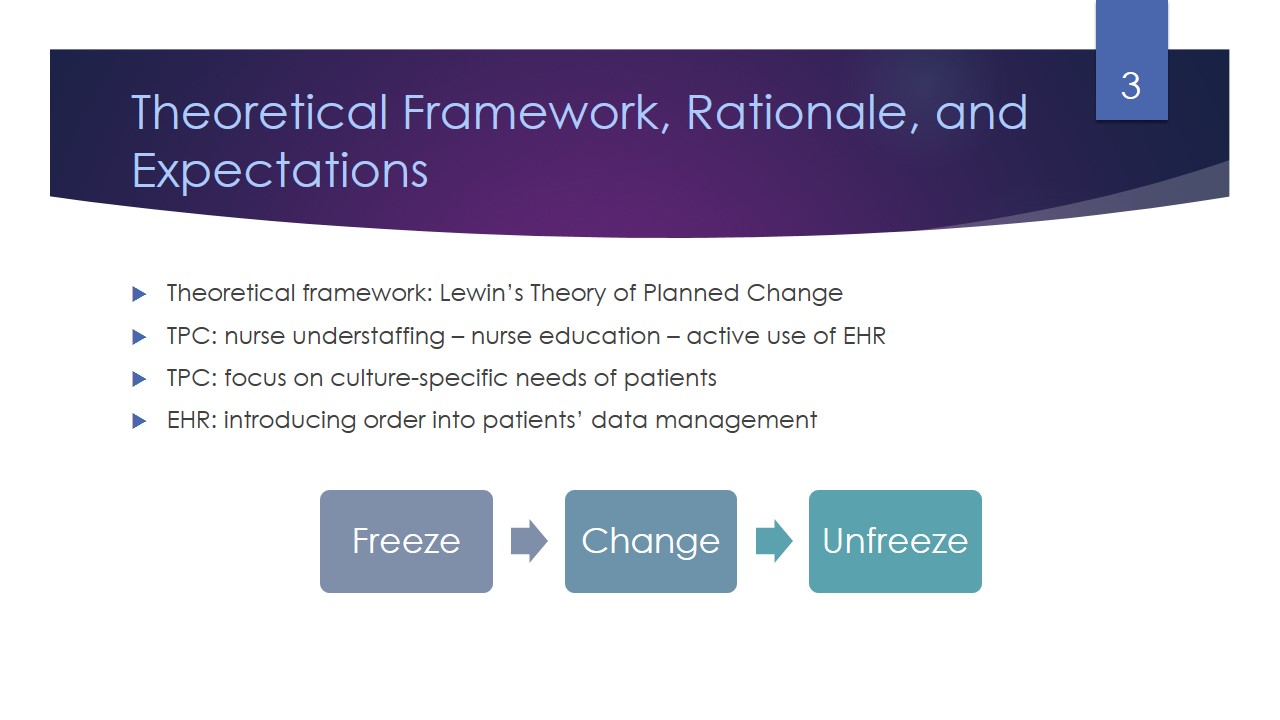
Analysis of the Literature: EHR in the ACU
- EHR: platform for building a coherent system of data management;
- EHR: ushering a new era of quality management into nursing care;
- EHR: enhancing the communication process;
- EHR: defining changes in patients’ health status.
EHR has opened a plethora of changes for optimizing the quality of care. Specifically, it has enabled nurses to manage patients’ health status remotely and control external and internal factors rigidly (Meeks et al., 2014). EHR also helps facilitate the communication process and perform crucial tests for determining changes in patients’ health dynamics (Furukawa, Jamoom, King, & Patel, 2013). However, the system has not been implemented at the nationwide level yet, with only 75.2% of hospitals using it (Adler-Milstein et al., 2015). Therefore, its further promotion in the ACU environment is critical to patients’ well-being.
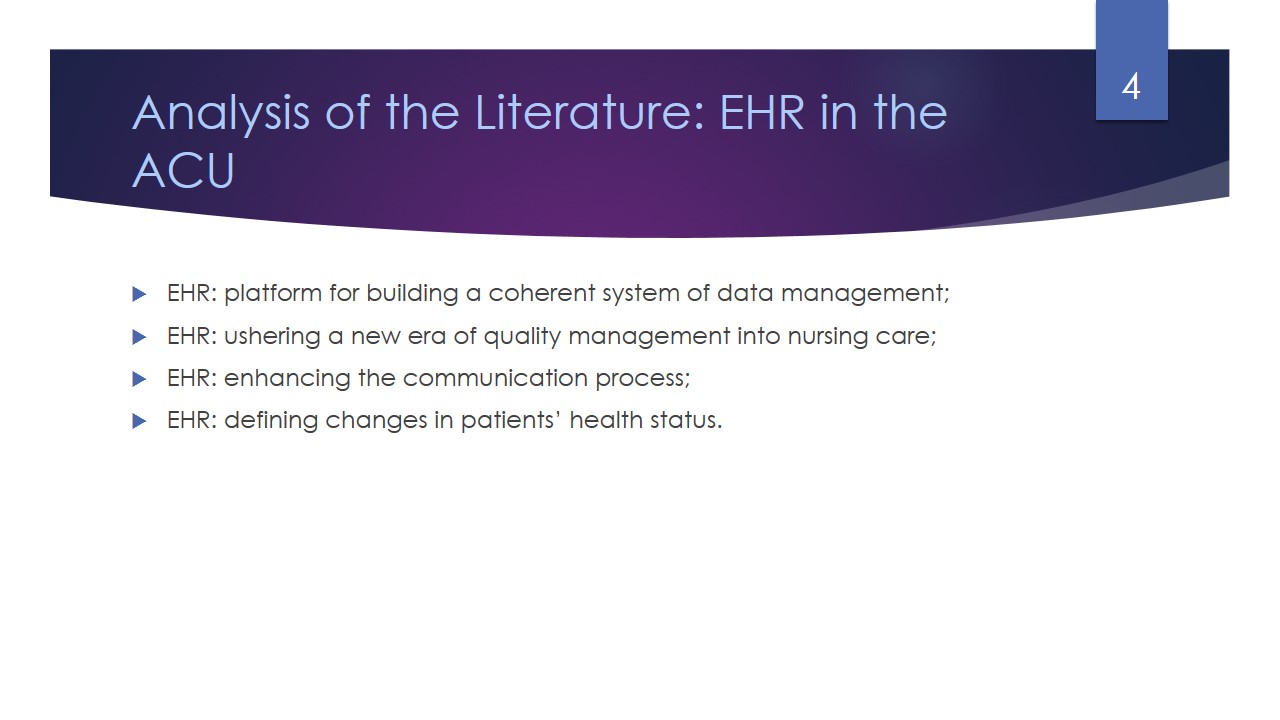
EHR in the ACU: Current Practices
- EHR: tool for enhancing the recovery rates among patients;
- EHR: essential component of decision-making in clinical care;
- EHR: platform for the clinical decision support (CDSS) system;
- CDSS: locating inappropriate use of medications;
- Future goals: establishing an EHR-based system nationwide.
The current practices involving the EHR system point to its efficacy and the role that it plays in increasing recovery rates. For instance, the application of EHR leads to the creation of the clinical decision support (CDSS), which implies a reinforced communication system and thus provides an opportunity to examine the processes associated with administering medications to patients. For example, Litvin, Ornstein, Wessell, Nemeth, and Nietert (2013) state that CDSS allows determining the wrongful use of antibiotics in nursing. Therefore, the promotion and institutionalization of EHR on a nationwide level should be regarded as one of the primary nursing objectives.
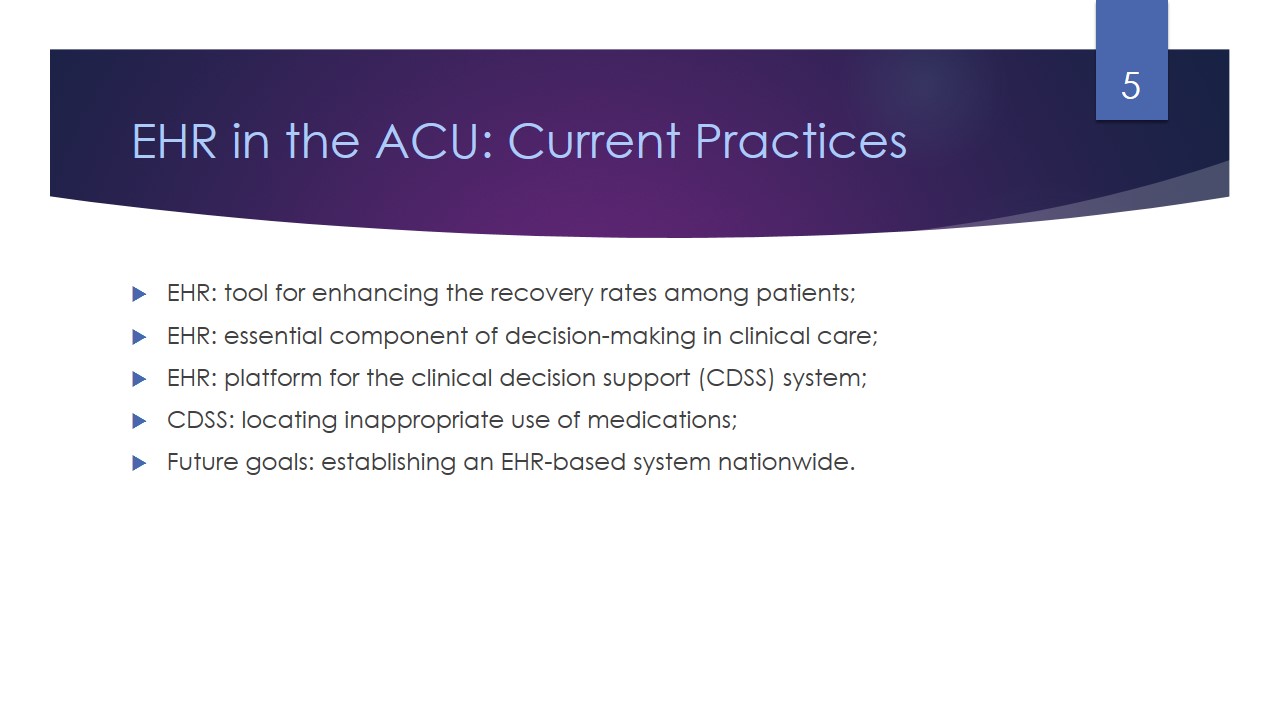
EHR in the ACU: Barriers and Benefits
- Barriers:
- uhuman (possible resistance to change),
- uprofessional (medical errors),
- utechnical (the lack of quality devices),
- uorganizational (mismanagement of resources),
- ufinancial (failure to reduce expenses),
- ulegal (legal restrictions within a state);
- Benefits:
- uquality improvement,
- ucommunication enhancement,
- udata management,
- uincrease in security levels,
- uinterdisciplinary collaboration.
EHR can also be seen as one of the keys to improving current clinical practice. The obstacles in question are particularly frequent in Saudi Arabian hospitals. Six types of obstacles are typically distinguished (human, professional, technical, organizational, financial, and legal ones) (Khalifa, 2013). Human and financial obstacles are typically seen as the most significant ones (Gartrell, Trinkoff, Storr, & Wilson, 2015). Indeed, software is very expensive, the total cost ranging from $1,000,000 to $10,000,000. Furthermore, teaching staff members to use the newly introduced tools as the means of data management is challenging as well. However, the project is bound to affect the quality of care positively and, thus help improve patient recovery rates impressively.
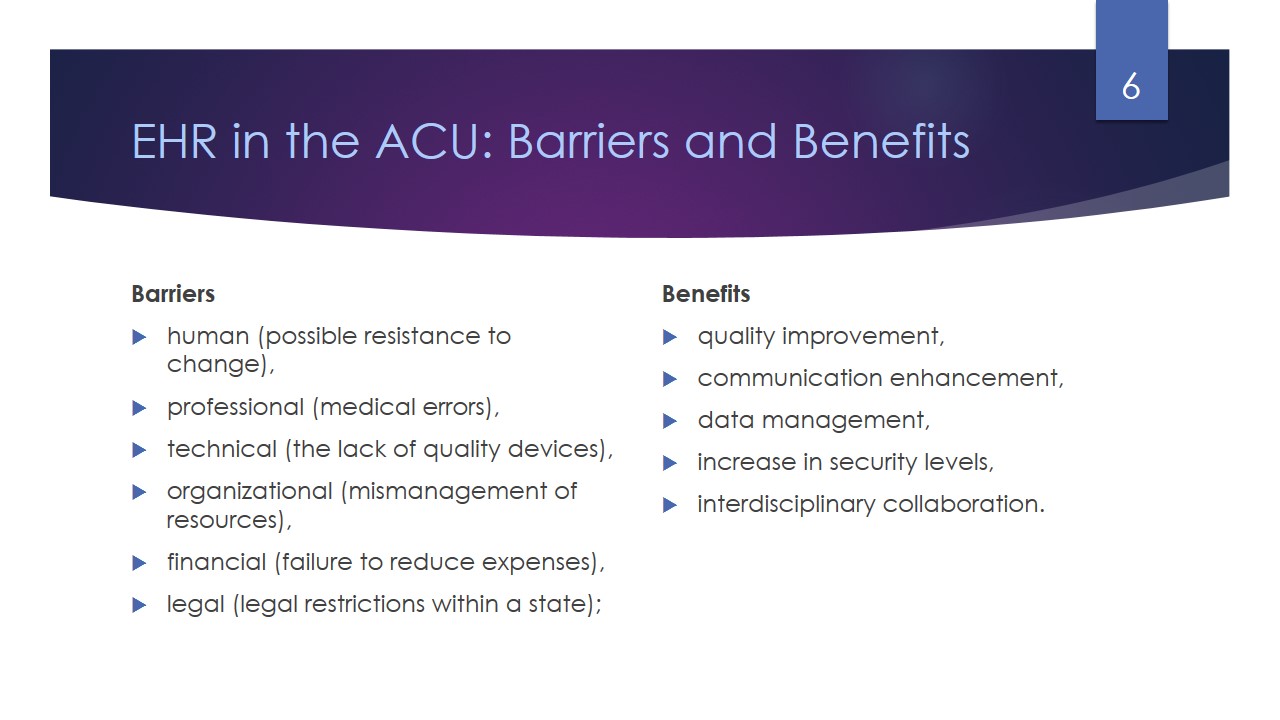
Methods: The Qualitative Design
- Study design: qualitative due to the focus on the nature of the issue;
- Study Methodology: phenomenology as the platform for exploring the issue;
- Data collection tool: survey based on specific questions.
Since the study concerns primarily the identification of the effects that the use of EHR has on the well-being of ACU patients and the performance of nurses, the qualitative design was chosen. The research survey helped to locate key trends in the provision of healthcare services in the ACU environment (Timmins, 2015). As a result, the platform for optimizing the current system was created (Habibi-Koolaee, Safdari, & Bouraghi, 2015). The survey included demographic and case-specific questions, whereas the sampling framework was based on the convenience sampling strategy.
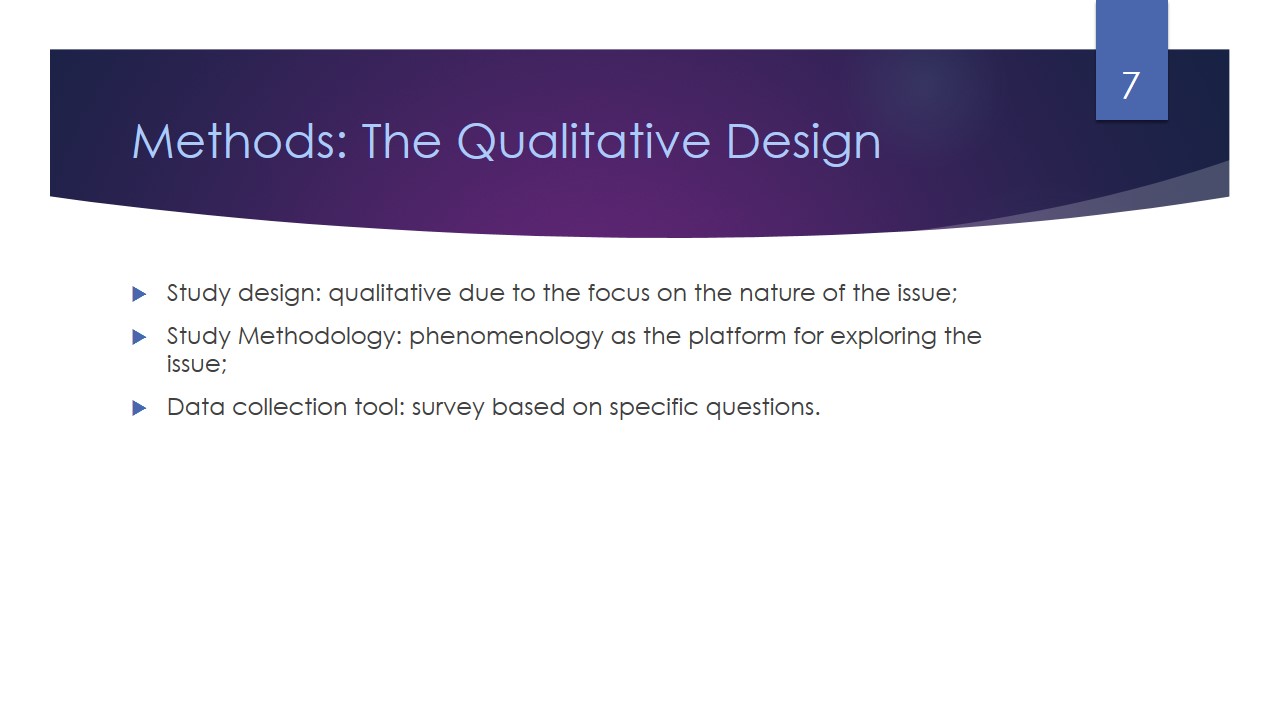
Methods: Sampling
- Sample: convenience sampling as the key strategy;
- Sample size: 10 participants (nurses for a local facility);
- Sample: highly qualified professional nurses;
- Sample location: nearby healthcare facility (ACU);
- Bowen formula as the basis for locating the sample size (Jones, 2017).
The sample included ten participants that worked in a nursing facility. The participants had a profound understanding of the needs of ACU patients and the ways in which EHR could be used to meet the set requirements and ensure patient safety during data transfer. The use of the convenience sampling framework implied certain limitations associated with representing the target population and delivering objective results. However, the issue was addressed by ensuring that all participants were highly experienced and, thus representative of different opinions, theories, and frameworks in nursing.

Data Analysis: Defining Key Trends
- Rapid increase in EHR popularity within the nursing sector;
- Active promotion of EHR use as the path to improving recovery rates;
- EHR: platform for building a coherent data transfer framework;
- EHR: reducing the chances of nurses making an error.
The use of the ANOVA tools helped distill key trends in the contemporary EHR practices in a nursing setting. Specifically, the results of the analysis indicate that the adoption of the EHR tools in the specified environment has become more popular over the past few years. Furthermore, the outcomes of the analysis pointed to the positive effects that the use of EHR has had on patients’ well-being. Specifically, the analysis has helped to prove that EHR contribute to the proper management of patients’ data, ab increase in its safety levels, and the drop in the probability of a medical error. Therefore, the application of EHR should be seen as highly recommended due to the extensive opportunities for improving care that the proposed framework provides.
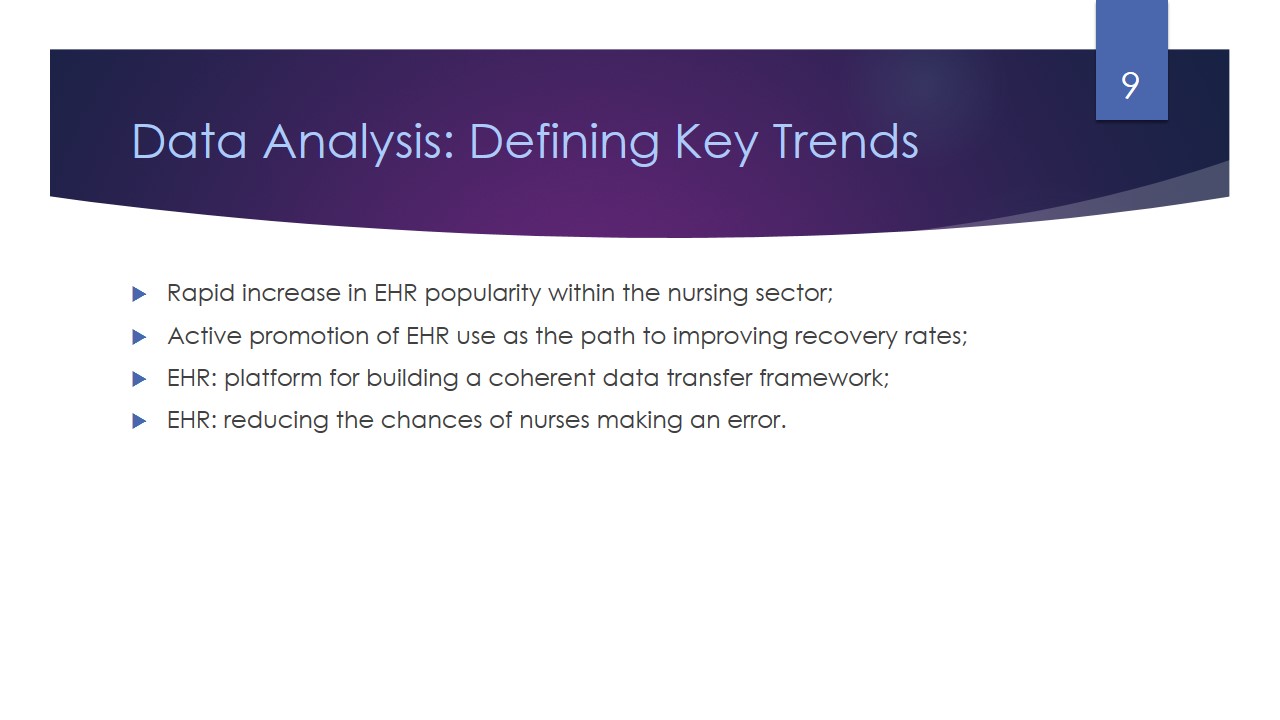
Data Analysis: Limitations and Delimitations
- Methods: primary source of research limitations;
- Sampling technique: the convenience method leading to underrepresentation;
- Surveys as the source of rather subjective data for the analysis;
- Delimitation techniques: choosing highly qualified nurses;
- Result: rise in the levels of research credibility.
Despite the impressive outcomes, there are certain limitations to the research results. Particularly, the method chosen by the authors poses additional threats to the veracity of research results. For instance, the choice of the convenience sampling technique may have caused underrepresentation of the target demographic and, thus led to a drop in veracity rates. In addition, the credibility of the research outcomes may be questioned since the authors of the study rely primarily on the subjective data obtained from nurses. However, the specified limitations ware addressed by introducing general questions and focusing on defining a common trend in the responses.

Conclusion and Recommendations
- EHR: a crucial tool for improving data management;
- EHR: a path to enhancing the quality of care;
- Methods of EHR introduction: redesign of nursing values;
- Institutionalization of EHR: training for nurses;
- Expected outcomes: an increase in recovery rates.
The technological breakthrough that has been made recently in the area of IT and data management has conditioned a shift in nursing perspectives. As a result, the introduction of EHR as the means of maintaining patient data security has emerged. However, the adoption of the specified framework requires significant changes in the modern nursing setting, in general, and information management, in particular. Nurses have to receive proper training in order to utilize the EHR system properly. Thus, a gradual rise in recovery rates among patients is expected.
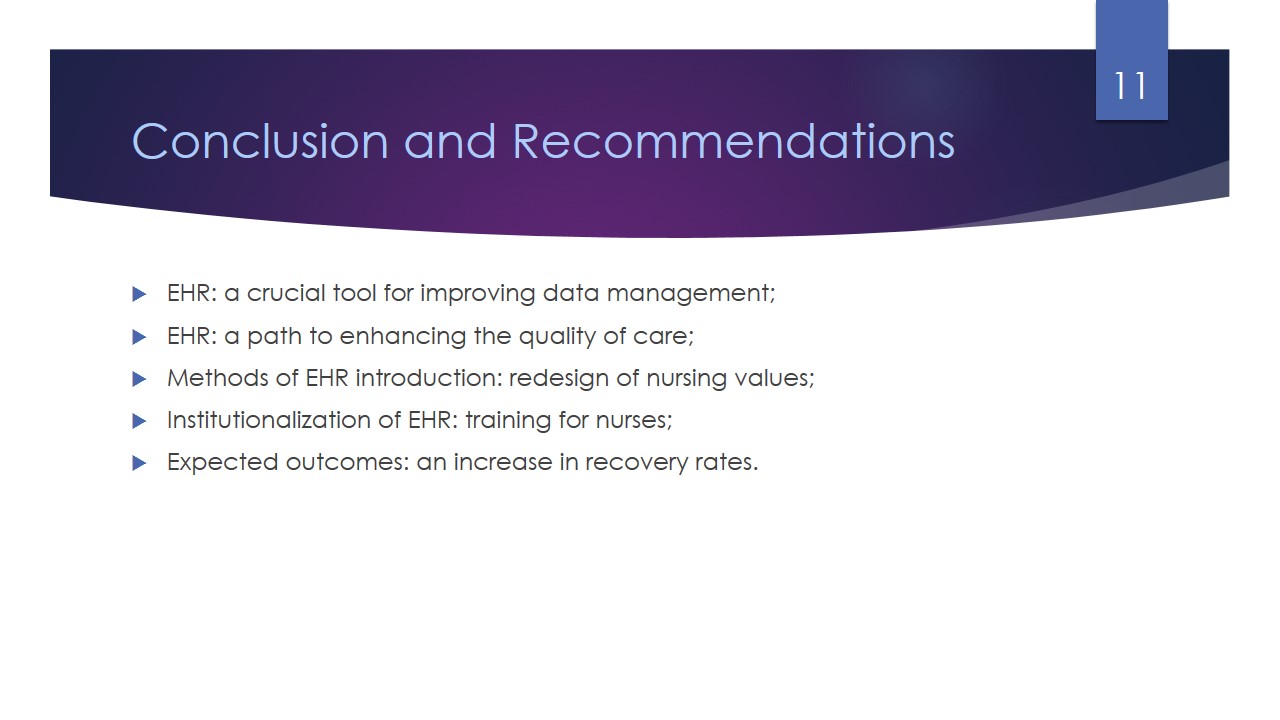
References
Adler-Milstein, J., Charles, D., DesRoches, C., Foster, G., Jha, A. K., Kralovec, P. & Worzala, C., (2015). Electronic health record adoption in US hospitals: Progress continues, but challenges persist. Health Affairs, 34(12), 2174-2180. Web.
Bakari, H., Hunjra, A., & Niazi, G. (2017). How does authentic leadership influence planned organizational change? The role of employees’ perceptions: Integration of theory of planned behavior and Lewin’s three-step model. Journal of Change Management, 17(2), 155-187.
Burke, W. (2017). Organization change: Theory and practice. New York, NY: Sage Publications.
Furukawa, M. F., Jamoom, E. W., King, J. & Patel, V., (2014). EHR adopters vs. non-adopters: Impacts of, barriers to, and federal initiatives for EHR adoption. Healthcare, 2(1), 33-39.
Gartrell, K., Trinkoff, A. M., Storr, C. L., & Wilson, M. L. (2015). Electronic personal health record use among nurses in the nursing informatics community. CIN: Computers, Informatics, Nursing, 33(7), 306-314.
Habibi-Koolaee, M., Safdari, R., & Bouraghi, H. (2015). Nurses readiness and electronic health records. ActaInformaticaMedica, 23(2), 105–107.
Jones, E. B. (2017). Factors associated with electronic health record use among nurse practitioners in the United States. The Journal of Ambulatory Care Management, 40(1), 48-58.
Khalifa, M. (2013). Barriers to health information systems and electronic medical records implementation. A field study of Saudi Arabian hospitals. Procedia Computer Science, 21, 335-342. Web.
Litvin, C., Nemeth, L., Nietert, P. Ornstein, S.& Wessell, A., (2013). Use of an electronic health record clinical decision support tool to improve antibiotic prescribing for acute respiratory infections: The ABX-TRIP study. (6), 810-816. Web.
Meeks, D., Sittig, D., Scott, J., Singh, H., Smith, M. & Taylor, L., (2014). An analysis of electronic health record-related patient safety concerns. Journal of the American Medical Informatics Association, 21(6), 1053-1059. Web.